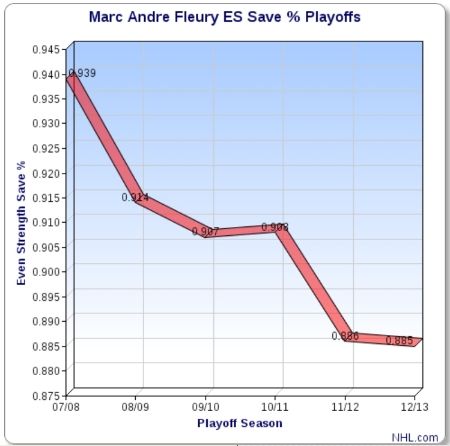Follow me on twitter
There has not been a lot of Penguins news to discuss as of late so I have been left to browsing through stats from previous years. Sometimes I come up empty but other times I stumble across statistical trends that I think are worthy of sharing.
Dan Bylsma is entering his fifth full season coaching the Penguins. Most of his tenure has been positive. The Penguins are consistently amongst the top teams during the regular season. The part where Dan Bylsma receives most of his criticism is the playoff stretch from 2010 to 2012. Bylsma’s Penguins lost to the Canadiens in the second round of the 2010 playoffs. They were then were ousted in the first round in both 2011 and 2012 by the Lightning and Flyers respectively.
Those early exits from the post season when combined with how the Penguins were swept out of the Eastern Conference Finals this year have been the source of vitriol for Bylsma’s harsher critics.
Sometimes you will hear the criticism that Bylsma took over Therrien’s team and that was the only year that he did anything in the playoffs.
I don’t subscribe to that theory and I have some numbers on why I feel that way.
It is a widely accepted concept that if you have the puck more often than the other team, your chances of success are higher. This is especially true when you have high caliber offensive players like the Penguins do. Below I am going to list the Penguins puck possession numbers from the 2007-2008 season to the present. I will be using 5 on 5 Fenwick For Percentage (close) as my metric.

Since Bylsma has taken over the Penguins from Therrien in 2009 they have been one of the better possession teams in the NHL. No coach’s system is perfect but the one Bylsma has used for the better part of his Penguins coaching tenure has had a high degree of success in the puck possession department. I think that by having the upper hand in the puck possession department during close games is the best way to find success.
So if the Penguins have had quality puck possession in close games, what has the problem been in the playoffs?
It’s really simple, Marc Andre Fleury.
A bad goaltender is all it takes to ruin a coach’s best laid out plans. Fleury has been a tire fire in the playoffs for the past couple of seasons and has been on a steady decline since his best playoff year in 2007-2008. I used this chart in a previous blog but I am bringing it back to drill home this point:

You can’t win playoff hockey games with goaltending like that.
Let’s focus back to the present season. In the puck possession chart above you can see that the Penguins regressed back to the middle of the pack. It was the first time in 3 years that they were not a top 5 possession team in close games. You are probably asking yourself why I am hyping up puck possession stats when the Penguins best playoff run in the past 4 years came in down year for their possession?
That is an extremely fair question. To answer it I will bring your attention right back to the goaltending position. Tomas Vokoun had an even strength save percentage of .933% during this year’s playoff run. Fleury hasn’t sniffed that number since 2007-2008. Competent goaltending solves so many problems.
The frustrating part about those possession stats is thinking of the what ifs? What if the Penguins received quality goaltending in the playoffs while they were also a top puck possession team? Unfortunately for the Penguins, they will never know.
To be fair, Bylsma and Shero do deserve some fault for the drop in the puck possession numbers this year. Playing Deryk Engelland over Simon Despres will definitely had a negative impact on Pittsburgh’s puck possession numbers. Despres had fewer offensive zone starts and played against a higher quality of competition than Engelland did,
yet Despres had a positive possession rating while Engelland was in the negative.
This mistake was similar to how the Toronto Maple Leafs consistently scratched Jake Gardiner for other less skilled but “tougher” defensemen. Once the Leafs bailed on that approach and played Gardiner against the Bruins they were able to generate speed through the neutral zone against Boston and come as close as you can to knocking a team out of the playoffs.
I believe that the Penguins fell into the trap of believing that they needed defense only minded defenseman in order to help out Fleury. The reality was that they needed to keep playing the same way and utilizing the best speed and skill lineup they had, while also benching Fleury.
Shero also decided that he would go after high profile veteran players like Jarome Iginla, Brenden Morrow, and Douglas Murray at the trade deadline. At the time the moves were applauded. In hindsight all three players brought a slower style of play and a negative possession rating.
Moving forward the Penguins are going to have to make some adjustments and focus back on what made them a top notch possession team. The Penguins need to play their speed and their skill, regardless of how old the player is or their experience level. That means Beau Bennett and Simon Despres should be in the lineup on a nightly basis. I believe that in 2013-2014 both players will indeed be a regular mainstay in the lineup which is a very good thing.
Bylsma’s “system” has actually worked during their playoff shortcomings; the only thing that needed to be changed was the goaltender. If the Penguins can find the same success they had in possession from 2009-2012 and combine that with Tomas Vokoun’s playoff numbers, watch out.
Thanks for reading!
You can find my non-Penguin related articles over at
HockeyHurts.com
Follow me on twitter

